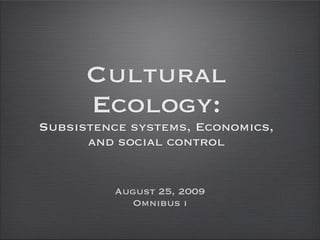
Cultural Ecology
- 1. Cultural Ecology: Subsistence systems, Economics, and social control August 25, 2009 Omnibus i
- 2. Cultural Ecology • The way people use their culture to adapt to their particular environments • Often associated with subsistence strategies
- 3. Subsistence Strategies • Foraging (Hunter/Gatherer) • Horticultural • Pastoral • Agricultural
- 4. Foraging • very small groups (less than 100 people) organized in bands • size limited by food supply in an area • men were primarily hunters, while women and children gathered berries, nuts, roots • egalitarian - if there was a chief, or “head man”, he was primarily an elder consulted for advice and influence • frequent movement meant few material goods, and minimal social stratification • pedestrian, equestrian, and aquatic (aquatic have the most permanent settlements)
- 5. Horticultural • Distinct from agriculture in that there is no domestication • Mostly seen in rainforests • Fairly egalitarian, with a “big man” • permanent villages can sometimes be erected • requires lots of land, as crops must be rotated each year due to farming practices • as a result, only small groups can be supported (under 200 people) in tribes • crops are not heavily tended - no irrigation, fertilizers, little weeding
- 6. Pastoral • Range from pure pastoral nomadism to transhumance • Typically in arid or mountainous regions where crops will not thrive • Movement takes advantage of water sources and grazing land • Hierarchy based on ownership, patriarchal tribes • Some surplus of food and more reliable food source, resulting in some division of labor and trade for other goods. • Besides dairy products and meat, animals also provided hair, leather, fertilizer, and transportation. • Some warfare over pasturelands. • Israel before settling in Canaan, approximately 1200 B.C. , was pastoral.
- 7. Agricultural • Indicates domestication, irrigation, and usually fertilizers • Domestication was an early practice of genetic modification through selective breeding of plants and animals, resulting in crops that produced the largest supply of good food, but required human intervention to continue. • Invention of the plow and the use of animals to prepare fields was crucial • Benefits - food surplus allows for division of labor and leisure time, allowing arts and sciences to develop • Downfalls - sedentism tends to result in increased warfare and disease; much more labor intensive
- 8. Agricultural (cont.) • With surplus comes trade, accumulation of goods, greater social stratification, and larger societies • Permanent settlements • Range from chiefdoms to nation-states
- 9. Industrial/Post-industrial • England was the first industrial society, beginning in the 1800s • Still rely on agriculture for food production, but their economic production relies primarily on machines • You will learn about the Industrial Revolution in detail in Modern Omnibus
- 10. Economic Systems • Two good definitions: • The provision of goods and services to meet biological and social needs and wants • A system of production, distribution, and consumption of resources • --- Reciprocity - sharing; giving items of fairly equal value in exchange for other items, either immediately or at a later time • ---Redistribution - all goods, food given to central leadership who apportion it amongst all members of the group • ---Market exchange - competitive buying and selling of commodities based on supply and demand; employs some type of currency
- 11. Social control and Political Systems: • Bands • Tribes • Chiefdoms • States
- 12. Bands • Foragers • Little social stratification, egalitarian • Head man - not an official position; based on leadership qualities, hunting ability and generosity; cannot accumulate wealth; often the religious leader and healer of the group as well • Strong sense of interdependency helps enforce order • Elders serve as guides and intermediaries, but decisions are made by consensus of the group • Reciprocal exchange
- 13. Tribes • Big Man - Not a full time position; must be good at diplomacy; may accumulate some wealth, but gives it back in feasts and parties; based on leadership ability, bravery, eloquence, diligence, generosity • In pastoral societies, he must coordinate migrations, arrange trade, maintain good relationships with people in areas where they may travel • A strong sense of identity, belonging, and family enforces order • Secret societies and elders also serve as social controls • Redistribution
- 14. Chiefdoms • Agricultural • With an increase of resources comes the need for a centralized, organized system of distributing those resources - this is what gives the central leadership their authority • More mechanisms of social control are needed, including spoken and written laws; police, jails, lawyers now needed • Chief - full-time position; based on birth, not achievement; may accumulate wealth and is often given gifts; may be advised by elders • Typically market exchange, though redistribution is still employed in smaller chiefdoms
- 15. States • First appeared in the Middle East circa 4300 B.C. • Codified law, both spoken and written (like chiefdoms, this requires police, jails, lawyers, etc.) • Social stratification, class systems based on economic resources • Permanent government, very specialized, bureaucratic • Bureaucracy - Administration of a government chiefly through bureaus or departments staffed with non-elected officials, relying upon fixed procedures to manage a large and complex organization • Many types of government possible - democracy, monarchy, oligarchy, republic, etc.